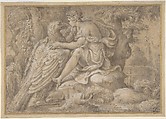Jupiter and Astraea
Giulio Campi Italian
Not on view
According to Ovid's 'Metamorphoses,' the most consulted mythological text in the Renaissance, when human wickedness forced the Gods to abandon the earthly realm, Astraea, the goddess of Justice, was the last to flee to the heavens where she transformed into the constellation Virgo. In Campi's drawing, Astraea, identified by an inscription at the lower right, Aestrit, is shown not with her scales but rather in an amorous embrace with Jupiter, who has taken the form of an eagle in order to seduce her. Jupiter was famous for the many guises he took to beguile his objects of desire, and this theme was popular in mid-sixteenth century Mantua in the circle of Duke Federico Gonzaga II. Campi's exquisite drawing was a preparatory study for a group of frescoes representing the many loves of Jupiter painted about 1545–50 for a small room in the Palazzo Aldegatti, which was owned by an aristocratic Mantuan family. The present sheet was acquired in 2003 from the collection of the great scholar and connoisseur of Italian master drawings Philip Pouncey (1910–1990).
Due to rights restrictions, this image cannot be enlarged, viewed at full screen, or downloaded.



